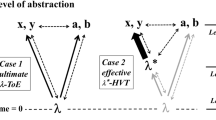Abstract
The author tries to formulate what a determinist believes to be true. The formulation is based on some concepts defined in a systems-theoretical manner, mainly on the concept of an experiment over the sets A m (a set of m-tuples of ‘input values’) and B n (a set of n-tuples of ‘output values’) in the time interval (t 1, ..., t k ) (symbolically E[t 1,..., t k , A m , B n]), on the concept of a behavior of the system S m,n (=(A m , B n)) on the basis of the experiment E[t 1, ..., t k , A m , B n] and, indeed, on the concept of deterministic behavior .... The resulting formulation of the deterministic hypothesis shows that this hypothesis expresses a belief that we always “could find” some “hidden parameters”.
Similar content being viewed by others
Bibliography
M. D. Mesarovic, ‘Systems Theoretic Approach to Formal Theory of Problem Solving’, in Theoretical Approaches to Non-Numerical Problem Solving (ed. by R. B. Banerji and M. D. Mesarovic), Proceedings of the IV Systems Symposium at Case Western Reserve University, Springer-Verlag, Berlin-Heidelberg-New York, 1970, pp. 161–173.
Author information
Authors and Affiliations
Rights and permissions
About this article
Cite this article
Materna, P. A formulation of the determinism hypothesis. Theor Decis 6, 39–42 (1975). https://doi.org/10.1007/BF00139819
Issue Date:
DOI: https://doi.org/10.1007/BF00139819




